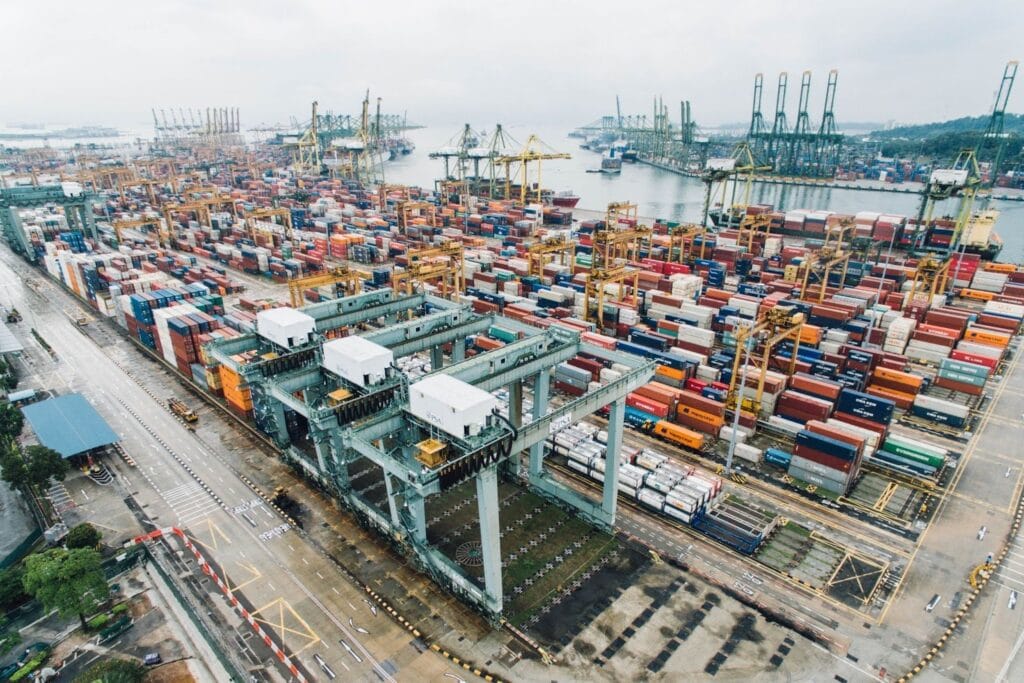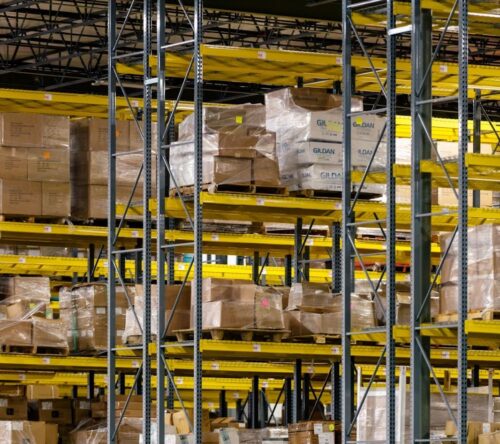Inbound vs Outbound Logistics: Processes, Comparisons, and Optimization

Both inbound and outbound logistics play important roles in the processes, comparisons, and optimization of supply chain management that businesses must understand to achieve maximum efficiency. These two types of logistics are essential for the smooth functioning of an organization’s operations.
This blog post will provide a thorough overview of inbound and outbound logistics, their respective processes, how they work together to form the supply chain, and optimization strategies to enhance your business’s logistical performance.
By delving into inbound and outbound logistics, you’ll gain valuable insights into inventory management techniques, warehouse management systems, and options such as considering a third-party logistics company and how it all plays a role in streamlining these processes. This understanding will equip you to make sound choices regarding the efficient management of your business’s logistical requirements.
What Is Inbound Logistics?
Inbound logistics refers to the processes and strategies involved in managing the flow of goods, raw materials, and information from suppliers to a company’s facilities. This crucial aspect of supply chain management ensures businesses have access to the necessary resources for production or resale. Let’s dive deeper into key performance indicators, challenges faced by businesses, and an example of inbound logistics.
Key Performance Indicators for Inbound Logistics
To measure success with inbound logistics, it is essential to track specific Key Performance Indicators (KPIs). Some common inbound logistics KPIs include:
- On-time delivery rate: The percentage of orders delivered on time by suppliers for inbound logistics.
- Average lead time: The average amount of time taken between placing an order with a supplier and receiving the shipment.
- Damaged goods rate: The percentage of received items that are damaged upon arrival.
- Returns processing efficiency: How quickly returned products are processed and resolved.
Challenges With Inbound Logistics
Inbound logistics can present various challenges for businesses, such as:
- Lack of visibility: Poor communication or outdated technology may result in limited visibility into inventory levels or shipment statuses that lead to inefficiencies in planning and decision-making processes for inbound logistics.
- Supplier reliability: Businesses must rely on their suppliers’ ability to deliver quality products on time; delays or inconsistencies can disrupt production schedules.
- Inventory management: Effective inventory control is critical for maintaining optimal stock levels and minimizing carrying costs with inbound logistics. Inaccurate inventory data can lead to stockouts or overstocking.
- Regulatory compliance: Companies must ensure that their inbound logistics processes adhere to various regulations, such as customs requirements for international shipments.
What Is an Example of Inbound Logistics?
An example of inbound logistics is a clothing retailer receiving raw materials like fabric, buttons, and zippers from suppliers. The company coordinates with multiple suppliers to receive these raw materials on time and in the required quantities.
They also manage transportation arrangements, track shipments’ progress, handle customs clearance if necessary, inspect received goods for quality assurance purposes, and store them appropriately until needed for production.
Inbound logistics refers to the receiving, storing, and distributing of incoming goods or raw materials. Outbound logistics, on the other hand, is the opposite. So inbound logistics involves preparing and delivering outgoing products for customers or other businesses.
What Is Outbound Logistics?

Outbound logistics focuses on the processes and activities involved in moving products from a company’s warehouse or production facility to its customers. This crucial aspect of supply chain management encompasses various tasks, such as order processing, warehousing, transportation, and distribution. A well-managed outbound logistics system is essential for businesses aiming to deliver goods promptly and efficiently while maintaining customer satisfaction.
Key Performance Indicators for Outbound Logistics
To measure the success of your outbound logistics operations, it’s critical to track relevant Key Performance Indicators (KPIs). Some common KPIs include:
- Order Accuracy Rate: The percentage of orders delivered without errors.
- Average Order Processing Time: The time taken between receiving an order and dispatching it.
- Average Delivery Time: The time taken for an order to reach its destination after being dispatched.
- Damaged Goods Rate: The percentage of orders that arrive damaged at their destination.
Challenges With Outbound Logistics
The effective management of outbound logistics can be challenging due to several factors. Some common challenges include:
- Inefficient Transportation Management: Poor route planning or vehicle utilization can lead to increased costs and longer delivery times.
- Limited Visibility into Supply Chain Operations: Lack of real-time data on inventory levels or shipment status may result in poor decision-making regarding stock allocation or shipping methods.
- Varying Customer Expectations: Different customers have different expectations when it comes to delivery times and service levels, making it challenging for businesses to meet all their needs.
- Regulatory Compliance: Companies must adhere to various regulations related to transportation, safety, and environmental standards in different regions or countries.
What Is an Example of Outbound Logistics?
A real-world example of outbound logistics can be seen in the operations of a large e-commerce company like Amazon. Once the customer has placed an order, Amazon’s fulfillment centers take over and process it quickly, utilizing sophisticated technologies to ensure optimal warehousing management and timely delivery. The items are then picked from inventory shelves, packed into boxes, and shipped using carriers such as UPS or FedEx.
Throughout this process, Amazon employs advanced technologies and optimization techniques to ensure efficient warehousing management and timely deliveries while minimizing costs.
Outbound logistics focuses on transporting products from a company to its consumers and is an integral component of any productive supply chain. By understanding how inbound and outbound logistics work together within the supply chain, businesses can optimize their processes for maximum efficiency.
How Inbound and Outbound Logistics Work in the Supply Chain

Inbound and outbound logistics are integral to the supply chain, enabling a seamless transfer of goods from suppliers to end customers while allowing businesses to optimize operations, cut holding and shipping costs, and enhance customer satisfaction. Comprehending how these activities collaborate can assist businesses in optimizing their procedures, lower expenses, and increase customer satisfaction.
The Role of Inbound Logistics
The inbound logistics process focuses on the procurement, transportation, storage, and handling of raw materials or components required for production. This process involves coordinating with suppliers to ensure the timely delivery of raw materials while minimizing inventory holding costs. Running an efficient inbound logistics process is essential for maintaining optimal levels of stock and avoiding production delays that could lead to lost sales opportunities.
Supplier Relationship Management (SRM)
- Maintaining strong relationships with key suppliers helps ensure consistent quality standards and timely deliveries.
- Negotiating favorable terms such as discounts or extended payment periods can result in cost savings for your business.
- Closely monitoring supplier performance allows you to identify potential issues early on so they can be addressed before impacting your operations negatively.
The Role of Outbound Logistics
The outbound logistics process, on the other hand, deals with the movement of finished products from manufacturing facilities to a designated distribution center or directly to customers. It includes activities such as order fulfillment and warehouse management systems implementation and operation optimization.
Efficient running of the outbound logistics process ensures that products are delivered quickly and accurately to a distribution center, which leads not only to increased customer satisfaction but also to reduced returns due to incorrect shipments being sent out. In summary, outbound logistics is critical in getting products to their final destination.
Warehouse Management System (WMS)
- Implementing a warehouse management system can help streamline warehouse operations, reduce errors, and improve overall efficiency with your outbound logistics process.
- A well-designed WMS enables real-time tracking of inventory levels and order status to ensure accurate fulfillment and timely deliveries for smooth outbound logistics.
- Integrating your WMS with other systems such as transportation operations management software or enterprise resource planning (ERP) tools can further enhance supply chain visibility and control.
In summary, the inbound logistics process focuses on the procurement side of the supply chain while the outbound logistics process deals with product distribution.
By understanding how these processes work together in the broader context of your business’s supply chain management strategy, you can identify opportunities for optimization that lead to cost savings, improved customer satisfaction, and increased competitiveness in today’s fast-paced logistics industry.
Inbound and outbound logistics are essential components of the supply chain and play a role in transporting products from providers to consumers. By optimizing these processes, businesses can improve their efficiency and reduce costs associated with managing inventory. Next, we will explain how companies can optimize inbound and outbound logistics for maximum effectiveness.
Optimizing Inbound and Outbound Logistics
Efficiently managing inbound and outbound logistics is crucial for businesses to maintain a competitive edge in the market. Streamlining processes at both ends can lead to significant cost savings, improved customer satisfaction, and enhanced operational efficiency. This section will discuss optimizing both the inbound logistics operations and outbound logistics processes and provide tips for achieving better results.
Tips for Inbound Logistics
- Establish strong relationships with suppliers: Building trust with your suppliers ensures timely deliveries, better quality control, and improved communication. Consider implementing supplier relationship management (SRM) practices to strengthen these partnerships.
- Leverage technology: Utilize advanced software solutions like transportation management systems (TMS), warehouse management systems (WMS), or enterprise resource planning (ERP) tools that help streamline inbound logistics processes by automating tasks such as inventory tracking, order processing, and route optimization.
- Prioritize visibility: Gaining real-time insights into your supply chain enables you to make informed decisions regarding inventory levels, transportation routes, and potential disruptions. Implementing track-and-trace technologies or using cloud-based platforms can enhance visibility across all stages of the inbound processes.
- Analyze data regularly: Regularly reviewing key performance indicators (KPIs) helps identify areas where improvements are needed within your inbound logistics process. Use this information to drive continuous improvement initiatives aimed at reducing costs while maintaining high service levels.
Tips for Outbound Logistics
- Diversify distribution channels: Expanding your distribution network to include multiple distribution channels, such as e-commerce platforms and brick-and-mortar stores, can help you reach a wider customer base while minimizing the risk of disruptions in any single channel with the outbound logistics process.
- Optimize transportation operations routes: Efficient route planning is essential for reducing transit times and fuel costs. Use advanced routing software or collaborate with third-party logistics (3PL) providers to optimize shipping routes based on factors like distance, traffic patterns, and delivery windows.
- Incorporate demand forecasting: Accurate demand forecasting allows businesses to better plan their outbound logistics operations by aligning inventory levels with anticipated sales volumes. This helps minimize stockouts or overstock situations that could negatively impact customer satisfaction. Learn more about effective demand forecasting techniques here.
- Maintain open communication with customers: Keeping customers informed about order status updates, potential delays, or other relevant information fosters trust and loyalty. Utilize communication tools like email notifications or mobile apps to provide real-time updates throughout the fulfillment process.
Taking proactive steps toward optimizing both inbound and outbound logistics processes can lead to significant benefits for businesses across various industries. By implementing these tips alongside continuous improvement efforts, companies can achieve higher efficiency levels while maintaining excellent service quality for their customers.
Optimizing inbound and outbound logistics processes can help businesses to reduce costs, increase efficiency, and improve customer satisfaction. Let’s delve deeper into this subject by taking a look at some of the commonly posed queries regarding optimizing inbound and outbound logistics.
FAQs
In this section, we will address some frequently asked questions related to inbound and outbound logistics.
What is air freight used for?
Air freight is a mode of transportation that involves the shipment of goods via airplanes. It is commonly used when businesses need to transport products quickly over long distances or when dealing with perishable items, such as fresh produce and pharmaceuticals. Air freight provides advantages over other transportation methods, such as faster delivery times, increased reliability, and improved security measures.
What is the contrast between air cargo and air freight?
Air cargo refers to any type of goods transported by an aircraft while air freight specifically denotes shipments made through a commercial airline’s cargo division. In essence, all airfreight can be considered as a subset of air cargo; however, not all air cargo falls under the category of “airfreight.” This distinction becomes important when considering different shipping options for your business since it impacts factors like cost structures and service levels provided by carriers.
What are the common challenges in managing inbound and outbound logistics?
Some common challenges in managing inbound and outbound logistics involve:
- Timeliness: Ensuring timely delivery of inputs for production (inbound) and finished products (outbound) can be challenging due to factors such as transportation delays, supplier or customer issues, and unexpected disruptions.
- Inventory Management: Balancing inventory levels to meet production and customer demands can be complex, especially when dealing with fluctuating demand patterns, lead times, and supply chain uncertainties.
What is the importance of cost optimization for outbound and inbound logistics?
Cost optimization helps organizations achieve operational efficiency in inbound and outbound logistics processes. By identifying cost-saving opportunities, streamlining operations, and minimizing wasteful practices, companies can enhance their overall competitiveness in the market. Efficient logistics operations allow organizations to offer competitive pricing, meet customer demands promptly, and gain a comparative advantage over competitors.
Conclusion
Overall, inbound logistics and outbound logistics are essential components of a comprehensive supply chain management strategy. Inbound logistics processes focus on the efficient movement of goods and materials into a business’s operations, while outbound logistics deals with the transportation of finished products to customers or a designated distribution center.
By optimizing both inbound and outbound logistics processes, businesses can reduce supply chain costs, improve inventory management, and enhance their overall logistics operations. Whether it’s through well-managed inbound freight that combines shipments or effective outbound truck routing, there are many ways to optimize your transportation operations.
